Yakovlev Yak-1 1942
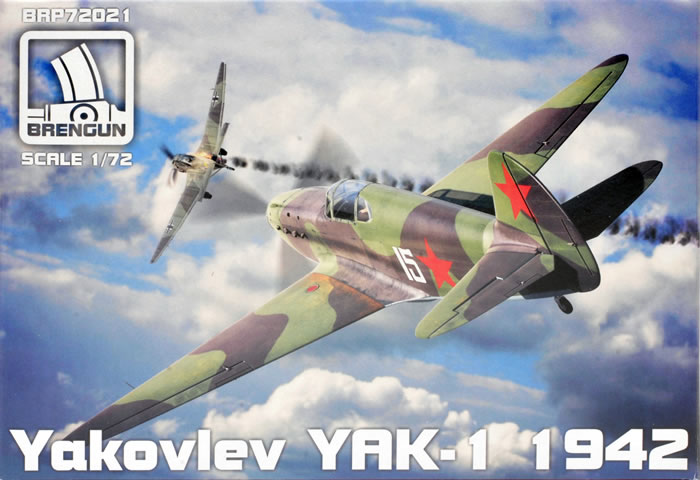
Brengun, 1/72 scale
S u m m a r y : |
Catalogue Number: |
Brengun Kit No. BRP72021 – Yakovlev Yak-1 1942 |
Scale: |
1/72 |
Contents & Media |
58 grey and 9 clear styrene parts, four resin parts, one PE fret of 15 parts, and decals for three aircraft. |
Price: |
Available on-line from these stockists:
Click here for currency converter. |
Review Type: |
First Look. |
Advantages: |
Very good detail, crisp moulding. |
Disadvantages: |
It is a pity that a PE set harness was not included in place of less necessary PE items. |
Conclusions: |
I think this is great little kit, despite its strange use of PE for some areas of surface detail. It is very well detailed, and the moulding is crisp and fine. I do feel that a PE seat harness should have been included instead of a pointless PE instrument panel, but this is not a deal-breaking issue.
The need for care with the wing to fuselage join is indicated, but this is from the only build article I have read. Overall, the kit appears well engineered.
Extra cockpit detail and a vac-form canopy are available separately from Brengun to enhance the model, but only make sense to me if an open cockpit is planned.
Although I do not own one to compare with directly, I am inclined to think this kit is superior to A-Model’s Yak-1 kit, if for no other reason than its representation of the fabric covered fuselage structure so characteristic of the real aircraft
|
Reviewed by Mark Davies

Eduard's 1/72 Avia B.534 IV serie Weekend Edition is available online from Squadron.com
The Yak-1 was maneuverable, fast and well armed, and it was easy to maintain and reliable. It formed an excellent basis for subsequent developments from the Yakovlev bureau. It was the founder of a family of aircraft, with some 37,000 being built.
At the time of the German invasion of Soviet Union on 22 June 1941, 425 Yak-1s had been built, although many were en route or still disassembled. 92 machines were fully operational in the Western Military Districts, but most were lost in the very first days of the war. The Yak-1 was designed with the goal of providing direct coverage of the Il-2 attack planes from enemy fighters. Thus, most of the air combat took place below 4,000 m (13,123 ft), at low altitudes where the Yak-1 performed the best. The Yak-1 proved to have a significant advantage over its Soviet competitors. A full circle turn took just 17 seconds in the Yak-1M. The MiG-3, which had the best high-altitude performance, did poorly at low and medium altitudes, and its light armament made it unsuitable even for ground attack. The LaGG-3 experienced a significant degradation in performance (as much as 100 km/h/62 mph on some aircraft) compared to its prototypes due to the manufacturer's inexperience with its special wooden construction, which suffered from warping and rotting when exposed to the elements. The Yak-1's plywood covering also suffered from the weather, but the steel frame kept the aircraft largely intact.
The aircraft's major problem early in deployment was fuel leaks caused by failure of spot-welded fuel tanks from vibration. Also troublesome was the fact that the canopy could not be opened under certain conditions in earlier models, potentially trapping the pilot in a falling aircraft. As a result, some pilots had the sliding portion of the canopy removed altogether. The first 1,000 Yak-1s had no radios. Installation of radio equipment became common by spring 1942 and obligatory by August 1942. But Soviet radios were notoriously unreliable and short-ranged, so they were frequently removed to save weight.
Like the Rolls-Royce Merlin float carburetor-equipped engines, the M-105 could not tolerate negative G forces which starved it of fuel. Moreover, they suffered breakdowns of magnetos and speed governors and emitted oil from the reduction shaft.
The Yak-1 was better than the Bf 109E, but inferior to the Bf 109F - its main opponent - in rate of climb at all altitudes, although it could complete a circle at the same speed (20–21 seconds at 1,000 meters). In comparison, a Bf 109, with its automatic flaps, had a lower stall speed and was more stable in sharp turns and vertical aerobatic figures. A simulated combat between a Yak (with M-105PF engine) and a Bf 109F revealed that the Messerschmitt had only marginally superior maneuverability at 1,000 meters (3,300 ft), though the German fighter could gain substantial advantage over the Yak-1 within four or five nose-to-tail turns. At 3,000 meters (9,800 ft), the capabilities of the two fighters were nearly equal, as combat was essentially reduced to head-on attacks. At altitudes over 5,000 meters (16,400 ft), the Yak was more maneuverable. The engine’s nominal speed at low altitudes was lowered to 2,550 rpm, and the superiority of the Bf 109F at these altitudes was reduced.
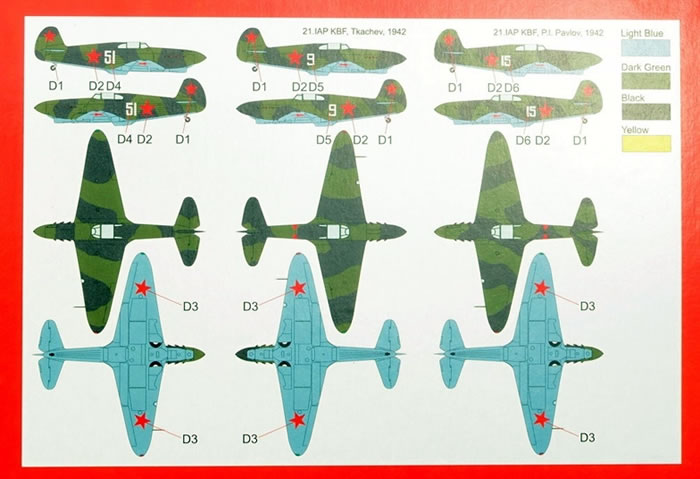
The Yak-1's armament would be considered too light by Western standards, but was typical of Soviet aircraft, the pilots preferring a few guns grouped on the centerline to improve accuracy and reduce weight. Wing guns were rarely used on Soviet fighters, and when they were used, they were often removed (as they were from US-supplied Bell P-39 Airacobras). Avoiding wing guns reduced weight and demonstrably improved roll rates (the same was true of the Bf 109F). The US and Britain considered heavy armament and high performance necessary, even at the cost of reduced agility, while the Soviets relied on the marksmanship of their pilots, coupled with agile aircraft. Even with the Yak-1's light armament, to reduce weight, modifications were made both on the front line and on about thirty production aircraft: the 7.62 mm ShKAS machine-guns were removed, retaining only the single ShVAK cannon.
Nevertheless, these lighter aircraft were popular with experienced pilots, for whom the reduction in armament was acceptable, and combat experience in November 1942 showed a much improved kill-to-loss ratio. Also, in the autumn of 1942, the Yak-1B appeared, with the more powerful M-105P engine and a single 12.7 mm UBS machine gun instead of the two ShKAS. Although this did not increase the total weight of fire much, the UBS machine-gun was much more effective than the two 7.62 mm ShKAS. Moreover, the simple VV ring sight replaced the PBP gun-sight because of the very poor quality of the latter's lenses. The Yak-1 had a light tail, and it was easy to tip over and to hit the ground with the propeller. Often, technicians had to keep the tail down, which could lead to accidents, with aircraft taking off with technicians still on the rear fuselage.
Nonetheless, the Yak-1 was well liked by its pilots. For Soviet pilot Nikolai G. Golodnikov, overall, in its tactical and technical characteristics, the Yak-1B flown by experienced pilots could meet the Bf 109F-4 and G-2 on equal terms. French Normandie-Niemen squadron selected the primitive model Yak-1M (that had a cut-down fuselage to allow all-round vision) when it was formed, in March 1943. Twenty-four of these aircraft were sent to the elite all-female 586 IAP, whose pilots included the world's only female aces: Katya Budanova, with 11, and Lydia Litvyak (11 plus three shared). Litvyak flew Yak-1 "Yellow 44", with an aerial mast, at first in 296.IAP and then with 73.Gv.IAP, until her death in combat on 1 August 1943. Another ace who flew the Yak-1 was Mikhail Baranov, who scored all his 24 victories with it, including five on a day (four Bf 109s and one Ju 87, on 6 August 1942). The Yak-1 was also the first type operated by the 1 Pu?k Lotnictwa My?liwskiego "Warszawa" ("1st Polish Fighter Regiment 'Warsaw'").
Soviet naming conventions obscure the fact that the Yak-1 and its successors — the Yak-7, Yak-9 and Yak-3 — are essentially the same design, comparable to the numerous Spitfire or Bf 109 variants. Were the Yaks considered as one type, the 37,000 built would constitute the most produced fighter in history. That total would also make the Yak one of the most prolific aircraft in history, roughly equal to the best known Soviet ground attack type of World War II, the IL-2 Shturmovik. But losses were proportionally high, in fact the highest of all fighter types in service in the USSR: from 1941 to 1945, VVS KA lost 3,336 Yak-1s: 325 in 1941, 1,301 the following year, 1,056 in 1943, 575 in 1944 and 79 in 1945.
Source: Wikipedia.org.
Previous 1/72 scale Yak-1 Kits
There have been a few previous Yak-1 kits in The One True Scale; here are those I am aware of, although there are probably others.
Possibly the oldest and most widely available kit dating from 1977is the ZTS Plastyk/Mikro 72 kit, which has been re-boxed by Mistercraft/Mastercraft. Accurate and really quite good for its time, it is looking a little dated now. However, adding Part’s PE set and a Falcon canopy can make for a very nice model. The Mistercraft/Mastercraft re-boxings have better instructions and decals than the original.
Armory released a resin Yak-1b kit with PE details. From what I have read about it, this kit is OK with good detail, but has vague instructions and fit of some parts is not the best. KPM released a vac-form offering three versions. According to Old Model Kits, it was a high quality vac- kit with fine recessed panel lines. Both of these kits fall outside the gambit of most modellers.
A-Model released a Yak-1 in several versions. Reviews I have read indicate that this is a good kit, and that it builds well for limited run offering, although some criticise it for its lack of scalloped fabric-covered areas on the rear fuselage. The most modern offering of this group, it was also probably the best all-round proposition, until now maybe...
Contents
The kit comes packed in a small box which has more than ample room for the compact contents. The box features artwork on the front and a quite small four-view colours & markings guide on its rear for three aircraft. Three grey sprues are enclosed within a re-sealable cellophane bag, with the decals, some resin parts, a PE fret and clear sprue further enclosed in a small bag of their own.
The instructions consist of a single folded A4 sheet giving four pages. They feature a parts map and well drawn assembly drawings. Text is in English and Czech. Scans of the instructions are included in the gallery images below.
New Style Tooling
Most Brengun kits have been moulded in a tan coloured styrene, whereas the Yak-1’s are grey, and appear different in tooling style. This is noticeable where the parts frames and gates are concerned, and I think that surface detail and smaller parts appear crisper and more cleanly moulded than before. It is likely Brengun has used a different third party toolmaker and producer, or their current partner has changed their tooling method.
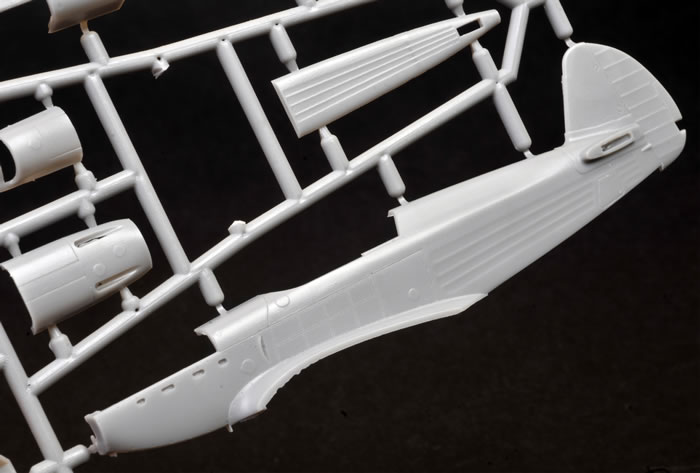
The sprues themselves have a tiny hint of flash in one or two places, but generally have a long-run appearance despite being limited run in nature due to the lack of locating pins etc. The clear parts are well done, and the resin and PE parts are of the good quality normally associated with Brengun.
The Kit Breakdown
The kit is available in two boxings, the other being BRP72020 Yak-1 1941, has the same parts but features a slightly different style of rear canopy section. Although not indicated, Brengun could offer a different fuselage sprue featuring the later Yak-1b’s low-back and bubble top canopy.
The first thing I noticed with this kit was the unusual large area recesses in the lower wing that are designed to receive inlaid PE panels (which I presume are the bottoms of the fuel tanks in the wings).
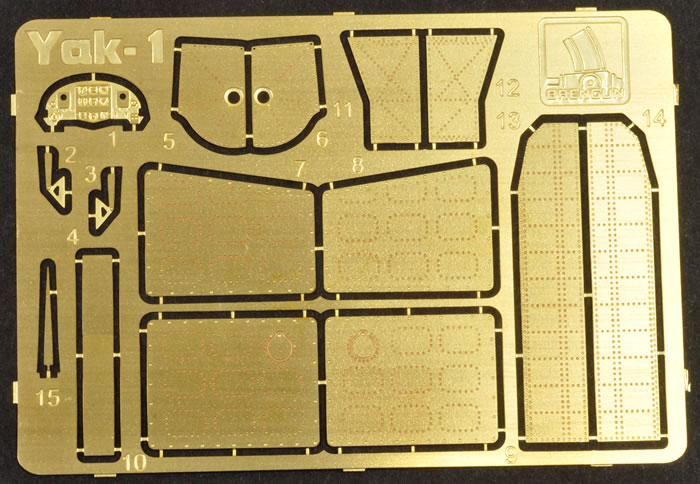
The rivet detail on the PE inserts is no finer than moulded detail elsewhere on the kit’s surface, so the reason for this approach is unclear. It occurred to me that it might be intended as a way to accommodate variations in underwing panel detail between versions; but after checking my references I found these panels have a different outline shape altogether on the Yak-3 and Yak-7, for example. Despite their apparent added complexity, a build article I read said they presented no problems.
Returning now to a more conventional review sequence, I shall mention the cockpit...
This is very nicely done, with quite a number of parts and very good levels of detail. The instrument panel is provided as a solid PE item; that is to say without open dial faces and a photo foil. As such, it offers no more detail than could have been moulded judging by the crisp styrene detail elsewhere in the kit. Yet despite the seemingly profligate usage of PE elsewhere, there is no PE harness to garnish the very nicely represented seat. The reason would seem to be that Brengun offers a small PE cockpit detail set that includes a harness, as well as an instrument panel with open dial faces (but no photo-foil). I think the harness should have been included with the kit at the expense, if necessary, of the pointless solid PE instrument panel. In addition, a gun-sight sits on a cross-fuselage brace as was characteristic of many Soviet WW2 fighters.
The nicely moulded canopy comes in three parts, but this cannot not be positioned open as the centre sliding section will not sit over the rear portion. However, Brengun offers a separate vac-form canopy that is ideal for an open canopy model.
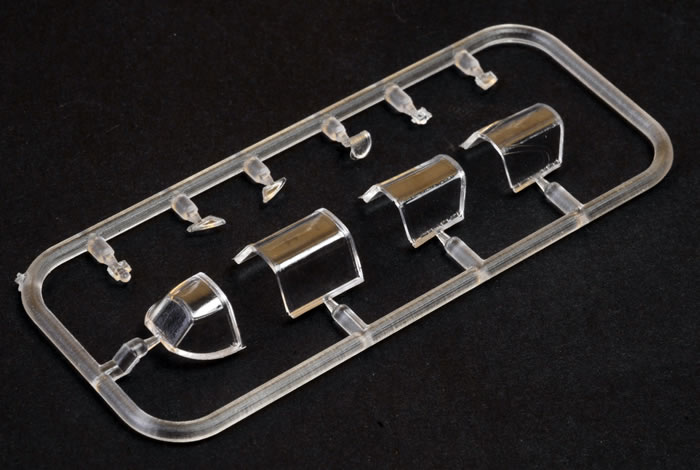
The fuselage is a bit of multi-part affair with the two main halves, a rear underside section (moulded separately to incorporate the fabric covered structure), and again for tooling reasons, a separate top to the cowling and oil-cooler intake for its underside. The oil-cooler matrix is provided as a resin part with some delicate detail. There is a choice of two styles for the lower section to the rudder’s trim-tab, but no guidance as to which colour scheme option each is intended. There are individual exhaust pipes to add to the engine cowl, which capture the fine and almost delicate look of the originals.
The instructions advise to remove trim off most of the tailplane’s locating tabs for them to fit the blind locating recesses within the fuselage. This is probably the best approach, but some may prefer to open the recesses and use the full area of the locating tabs.
The wings include integral wheel well detail on the inside of their upper surfaces, and have separate wheel-well enclosures to sandwich between the wing halves. A nice touch is the clear landing light and wingtip nav-lights. The radiator bath is separate, and includes a moulded insert and resin matrix face. The lip for the carburettor air intake is a separate part that snuggles into the port wing-root. I think this is a very effective solution to what can otherwise be a tooling challenge with kits of Yak fighters.
PE is again used to represent the flaps, and these fit into a recessed area in the same manner as the fuel tank undersides mentioned earlier. Like the fuel tank faces, there is no obvious reason for this approach, as the flaps are not suitable to pose lowered due to a complete lack of internal structure detail.
The undercarriage is particularly well executed, capturing nicely the somewhat complex shape of the main legs and their retraction arms. The main and tail-wheel leg all have separately moulded torque links to add. The main wheels are resin, and the undercarriage doors are PE, which makes good sense.
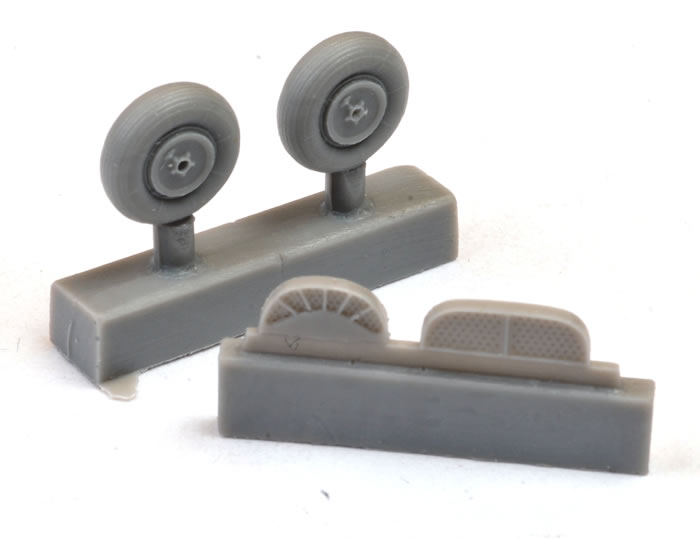
All that remains to mention concerning parts is a propeller with separate spinner and a pitot for the wing.
A build article I read indicated that general the fit is good, but that there are issues with the wing to fuselage join. It seems that if the wings are correctly aligned with the roots on the fuselage one is left with a gap at the front of the join, or if fitted to eliminate this gap there is a step at the rear of the root. Obviously, some dry fitting and fettling may be necessary.
The change in tooling style is a definite improvement on Brengun’s previous but still worthy kits, as the Yak-1 has far less of a limited run feel to it than previous releases.
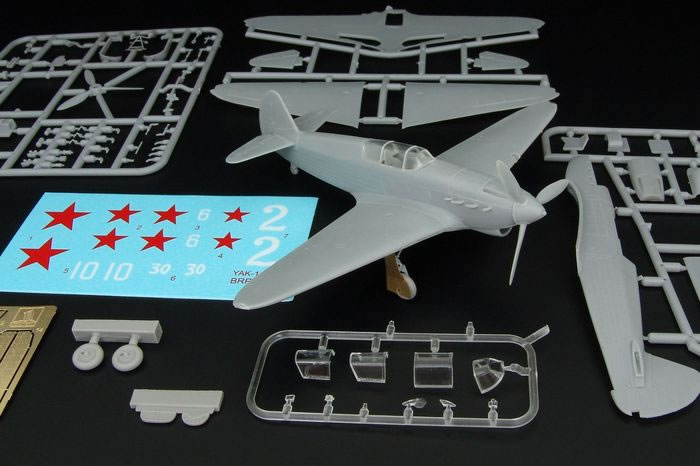
Here are some images of the assembled but unpainted model from Brengun’s website.
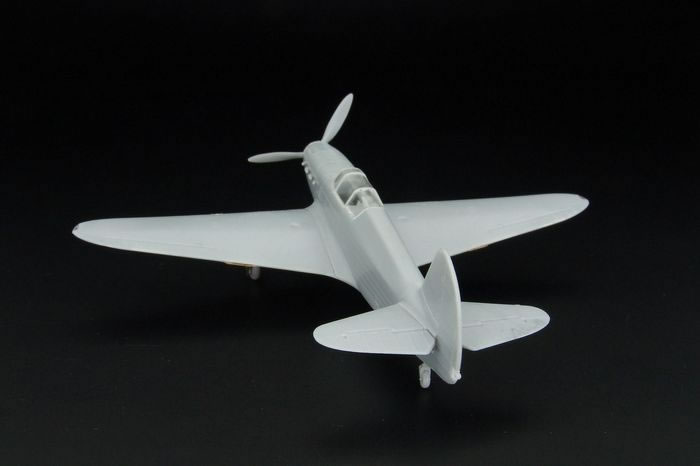
Colours and Markings
Colours and markings are very simple, with all three choices appearing very similar to one-another.

The decals are crisply printed with good registration, and colour density looks good.
I think this is great little kit, despite its strange use of PE for some areas of surface detail. It is very well detailed, and the moulding is crisp and fine. I do feel that a PE seat harness should have been included instead of a pointless PE instrument panel, but this is not a deal-breaking issue.
The need for care with the wing to fuselage join is indicated, but this is from the only build article I have read. Overall, the kit appears well engineered.
Extra cockpit detail and a vac-form canopy are available separately from Brengun to enhance the model, but only make sense to me if an open cockpit is planned.
Although I do not own one to compare with directly, I am inclined to think this kit is superior to A-Model’s Yak-1 kit, if for no other reason than its representation of the fabric covered fuselage structure so characteristic of the real aircraft.
I happily recommend this kit, and am sure VVS enthusiasts will welcome it.
Thanks to Brengun for the review sample.
Review Text Copyright © 2016 by Mark Davies
Page Created 23 December, 2016
Last updated
23 December, 2016
Back to HyperScale Main Page
Back to Reviews Page |
